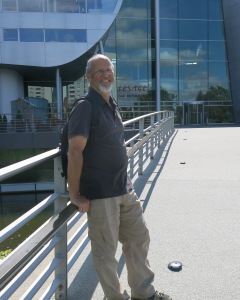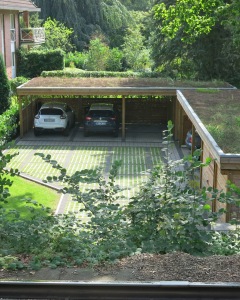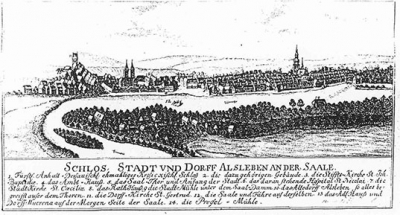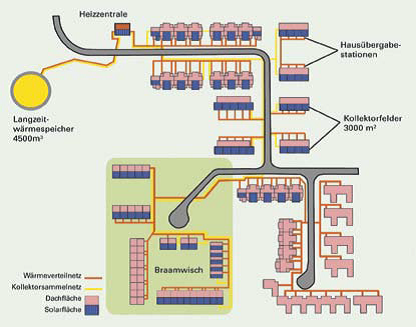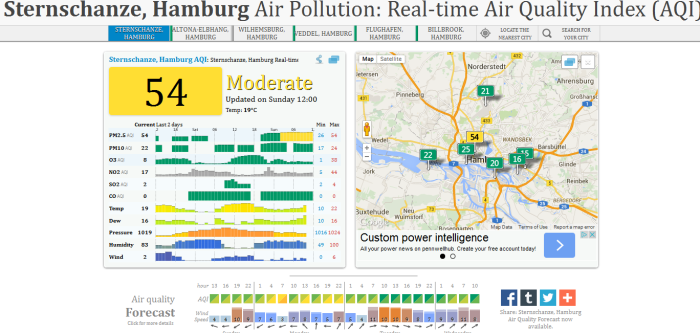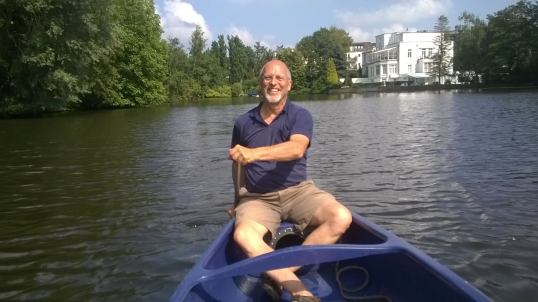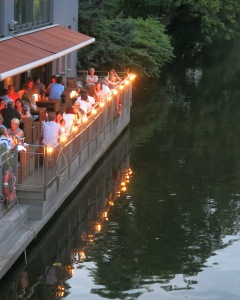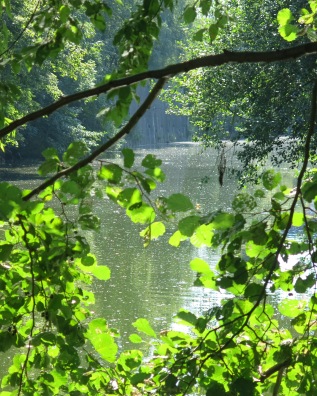Archive for September 2015
Say it ain’t so, Herbie!
A car isn’t just a means to get places. It’s a social signifier. Some cars send messages louder than others, and not always good ones. Think of the symbolism associated with a brand such as Hummer (insecure sociopath), a Cadillac (pimp), a Corvette (bad in bed, must compensate somehow), a Buick (dignified senility – except in China, where they are hugely popular). There are many others like that, though some cars are just meh.
But Volkswagen? The cool car? The love bug? The rebellious, hippie, birkenstock granola car? Say it ain’t so! The sense of betrayal is palpable out there – just look at Greenpeace France’s view of it, above. Volkswagen’s counter-culture image was forged in the sixties, and we’ve been saddled with it since. But the company now is the establishment: the biggest car maker in the world, with a stable that includes Bentleys and Audis. Still, what transpired this week comes as a shock. Especially from a company with a strong, public environmental commitment.
So what exactly happened? An environmental NGO, ICCT, decided to test a few Diesel imports (a Passat and a Jetta, both VW models, and a BMW X5) under real-life conditions. When the emissions of the pollutant NOx were found to be much, much higher than expected, they alerted the EPA. The American agency confirmed the results, threatened to withdraw the import permit of diesel VWs, and the company fessed up: their cars are equipped with a software that alerts the engine controls that it is undergoing a test, and adjusts the engine so as to reduce the emissions. Indeed, the engine can run without producing significant emissions, but that means that the car is less peppy, and also uses more fuel. Basically, they cheated.
By now, the issue has been all over the world news (here in the German papers, it managed to displace the refugee crisis as issue number one). So I won’t add to the collective indignation, but I want to point out one conundrum, all too common when tackling climate change.
In a diesel engine, NOx are produced when the engine runs optimally. Controlling NOx takes away some energy from the engine. So, it’s not just engine peppiness; it’s the amount of greenhouse gases that it emits. I doubt that Volkswagen folks will try to use this as an excuse, but the fact remains: trying to remove a pollutant that is toxic (NOx) adds to the emissions of a climate change pollutant (CO2).
Why is that? It has to do with the type of NOx control used on VW smaller models. There are three strategies to control the pollutant. NOx are formed when the oxygen in the air reacts with the nitrogen in the air. This reaction only happens at high temperatures, which is why diesel engines, which run hotter than gasoline engines, emit more NOx. So, strategy number one consists of lowering the combustion temperature or letting in less oxygen in the combustion chamber. This is usually done by mixing a bit of exhaust gas to the intake air. But then the result is less efficiency, so higher fuel consumption, so more greenhouse gases.
The other two strategies remove the NOx after the fact. One injects urea into the exhaust over a special catalyst; this produces a reaction that removes the NOx. It adds to the complexity of the controls, requires a special tank of urea, and as a result this strategy is more common in heavier, luxury vehicles. (Yes, urea as in what’s in urine; it’s marketed as Diesel Exhaust Fluid, or DEF, for polite society.)
The final approach uses what’s called a Lean NOx Trap, LNT for short. It uses a set of metal compounds that can adsorb the NOx like a sponge. When the sponge is full, a squirt of fuel is added; the adsorpbent metals also act like a catalyst, causing NOx to react with the fuel and turn into innocuous nitrogen gas. The other products of the reaction are water and, you guessed it, the greenhouse gas CO2. This is the system that Volkswagen uses in its smaller models, because it is simpler and lighter.
And, apparently, it can easily be rigged to work only when you’re at a testing station. Clever! But no, not cool, not when NOx is linked to asthma, heart attacks, you name it.
Oh yeah, what about that Beamer that passed the test? Apparently it uses the urea system. So it’s all good, is it? Well, maybe not. Just a few days before the VW scandal exploded, a European ENGO (Transport and Environment) speculated that many manufacturers may have installed so-called “defeat software”, since their own tests showed a huge discrepancy. In their tests, Audi and Opel came out much worse than Volkswagen, and even BMW didn’t look too good. Go figure, but something does stink there.
At the Volkswagen factory in Dresden (clean and transparent)
Life is full of ironies. Visiting a city that is a gem of baroque architecture, after finishing a bicycle trip, Dinah and I went to visit…an ultra-modern car factory.
Weird, eh? It gets worse. We couldn’t even get a tour; there are 20-people tours every hour, but they must be booked way in advance. In fact, the VW factory it is one of the more popular sites on TripAdvisor for Dresden, and has been voted one of the world’s “25 most beautiful factories“.
Don’t worry about our sanity: we also did visit the famous Church of our Lady and the Augustinum. But I was keen on the factory, because it’s unique.
It’s fully transparent, for one thing. The assembly line for luxury Phaetons and Bentleys – that’s what the factory is – winds in a descending spiral encased in glass. Visitors see the cars gradually take shape (and thankfully visible even from the outside). Buyers can follow their future car floor by floor, if they wish.
The original appeal, for me, had to do with urban planning. Bringing industrial jobs to the centre of a city is always a challenge, but it seemed VW was up to the task. They had selected an assembly line – a process relatively free of pollution and noise – to bring jobs to the heart of former East Germany. But instead of a regular assembly line, they opted for a spectacular, fully transparent building, which continues to do wonders for them in terms of PR and free advertising. But there’s much more to the plant than good PR.
Dinah first noticed what a pleasant work environment the plant is. There’s no substitute for natural light, and natural ventilation, when working indoors. That means workers who are happier and more productive, a far cry from the old DDR. VW boasts of involving its employees in decision making when it comes to improving assembly line efficiency; I see no reason to doubt that (as of 2014,VW had propelled itself to number two among world car makers, so maybe there’s something about proof and pudding…).
Natural light and ventilation also mean energy savings for a building, at least a well designed one, which this one is. But the environmental aspects of the building don’t stop there. There are speakers chirping bird sounds outdoor (I was wondering what that was, as I couldn’t see the birds). The bird songs are designed to fool real birds into thinking the site is already occupied – so that they don’t crash into the windows, always an issue with glass buildings. And the outdoor lighting is also designed to “operate in a yellow spectral range that does not disturb insects in the nearby Botanical Gardens.” An auto plant that looks after the birds and the bees, who knew!
Special care was also taken to ensure good water management. Compared to the previous site use, the impervious (sealed) area was reduced from 6.7 to 4.8 hectares. This opened up space to plant 350 trees, as well as ponds that can store excess storm water and recharge groundwater.
(Stormwater management is always a concern in Dresden, as everywhere along the Elbe. During the massive flood of 2002, the factory atrium served as a venue for Carmen, since the baroque opera house was flooded and inaccessible.)
One of the problems with a downtown factory is supply. No-one welcomes a continuous stream of rumbling trucks. But this is where a well-established downtown provides an advantage in terms of transportation. Dresden has an extensive network of streetcars. So with a bit of ingenuity, some tramways were converted to goods transport, which can be done without disrupting transit passengers, impeding traffic, or creating unbearable noise on the cobblestone streets.
I wouldn’t have known about any of this, but missing out on the tour forced to do my own research (lack of organisation pays off sometimes). Dresden was lovely, don’t get me wrong; but sometimes it’s the absence of things that make the biggest impression. No smoke, no noise from a factory that churns twenty cars a day. Wow.
Doing that research got me on to VW’s site, looking at the company’s environmental statement. The company has pledged to reduce its footprint by 25% by 2018. That’s 25% less water, solvent, and energy use, less wastes and CO2. And then there’s this: “92 g CO2/km by 2020; VW group is backing the European emissions target”. Now that’s impressive, considering that this is a company that makes Audis and Porsches. A North American company would have threatened a law-suit, would have denounced the government’s directive as “job-killer”. Not here. Is Volkswagen merely playing coy?
A factory that does pollute or disrupt downtown life? Yes. A car company that is making progress towards environmental sustainability? Maybe. Here are a couple of quotes from the report.
In June 2013, Audi became the world’s first vehicle manufacturer to open its own power-to-gas plant – in Werlte, Germany. This project presents a solution to one of the big challenges facing Germany’s“energy transition”, by offering a way of storing renewable electricity independently of where it is generated, in large quantities and over long periods. The plant first of all splits water into its component oxygen and hydrogen atoms. The hydrogen is then reacted with waste CO2 from a biogas plant to produce synthetic methane – Audi e-gas. This gas… is fed into the natural gas grid and distributed to CNG filling stations. The plant began supplying Audi e-gas to the grid in late 2013. Annual production of the Audi facility is expected to be in the region of 1,000 t of e-gas, absorbing 2,800 t of CO2 in the process. The amount of e-gas produced in Werlte would enable 1,500 Audi A3 sportback g-tron• models to travel 15,000 km a year in virtually carbon-neutral style.
“SEAT a l Sol”, current ly the world’s largest photovoltaic plant in the automotive sector, came on stream in November 2013. The plant comprises 52,827 solar panels with a ma ximum rated output of 10.6 MW, and covers an area of 276,000 m² on the roofs of six ha lls and four storage areas for finished vehicles. [Prior to that], in January 2013 the Volkswagen brand brought on stream what was at the time the world’s largest solar power plant. The Volkswagen Chattanooga Solar Park generates a peak output of 9.5 MW and it remains the largest solar power plant operated by an automaker in the USA. Its approximately 33,600 solar panels are expected to yield around 13,100 MWh per annum, which would cover 13% of Chattanooga’s electricity requirements at full production capacity.
Then again, there’s this, from Wired: “The EPA is accusing Volkswagen of illegally using software to cheat emissions standards, allowing the German automaker to sell half a million cars that produce nitrogen oxide, which creates smog, at up to 40 times the legal limit.” Hmm.
The house at Hoheneichen
Like Vancouver’s skytrain, many of the local lines here are elevated, despite their name (U-bahn stands for “underground railway”). On my way to the Solar Siedlung I saw from the train window a cool house at Hoheneichen station. I stopped on the way back to check it out.
There’s nothing all that special about this house; it’s not in any government brochure or guidebook about new, progressive initiatives. Still, it would stick out like a sore thumb in Vancouver. It is a large house divided in four dwellings (judging by the mailboxes). But it is equipped with solar panels, for one thing, and it’s probably also highly insulated and energy efficient.
It also features something that we love to talk about in Vancouver, but in practice see all too rarely: it handles rainwater in a good, logical fashion: the roof of the garage is planted as a green roof. The parking itself is green, using porous pavers. I couldn’t see the roof but I wouldn’t be surpised to hear that the solar panels sit on a vegetated surface – a green roof.
Why does that matter? Well, of course the solar panels are cool, a sign that modern appartment living does have to consume a huge amount of energy. But I want to focus on the rainwater management features.
It is really cool to see the green roof and porous pavement used in an unheralded house. This is just a house, not some eco-demonstration project. Yet, most of the time when it rains (and does it ever in Hamburg!), this house does not load the storm sewers with runoff. Which means that during really big storms, this house does its part in preventing flooding.
We talk about this in Vancouver, and say it’s important. Yet few concrete measures are in place to encourage such designs. In Hamburg, by contrast, part of the property taxes are based on the amount of impervious surface; green roofs , raingardens, porous pavers, none of these are considered impervious, and so reduce taxes. This is a measure that has been implemented by the city in 2009, in response to a European Union agreement on preventing flooding, the 2000 EG wasserrahmenrichtlinie (details here in this excellent brochure, in German though).
Maybe the reason such measures are implemented is that many people remember the devastating 1962 flood. The flood of 2013 was actually worse, if you use as a measure the height of the river Elbe; but nobody died in that one, compared to 315 people who died in ’62. This is probably why there is popular buy-in in the measures adopted to prevent flooding.
In Vancouver, we have no such collective memories. Few people know of the Matsqui flood of 1948. For that matter, there is little awareness of our water situation, be it drought or flood risks. You’d think we would heed the lessons of Calgary’s flood in 2013, or Toronto’s in 2014. I’d love to see the adoption of measures that encourage good water management, as in Hamburg – but will it happen?
Meanwhile, this city never ceases to amaze me: even a mundane trip turns into a discovery journey. Yes, I’m lucky to be visiting here.
Plastic Sea (a poem on the Alster)
Doing some research about the Alster, I ran across a poem written by Mirko Bonné for Weather Stations, an international project exploring literary responses to climate change. It is quite long and can be read in its integrity here. But here are some excerpts, to get the flavour of it; do please go to the original.
If you need a theme, it can be said to be about the plastic pollution of the oceans – but it’s much more than that. I’ve been walking up and down different reaches of the river – maybe that’s why I find it unexpectedly moving, as I slowly connect history, water, and environment. Read on, you’ll see what I mean.
The thin ribbon of water that flows
down to Hamburg beneath
locusts and ash trees, but mainly
old birches, where ducks live and coots
that dart off mutely, smelling of the swamps
in the quiet old woods of Stormarn and Holstein,
is called the Alster, and is and always was
a river. It was made into two lakes in the middle
of the great Hanseatic city only when Adolf
III returned to the city from the crusade
in the Holy Land and ordered a miller
to dam the stream with mighty dikes
that would have stopped even the Elbe’s
flow. Then a northern sea spread out
amidst the wooden town; all the Holstein waters
of the Wöddelbek, Rönne, Wischbeck and Lankau,
the Sielbek and the Tangstedter Mühlenbach
flowed and could not drain; within weeks
the relentless element, flowing
on and on, grew vaster and
broader, grimly unstoppable,
until first the Outer, then the Inner
Alster (not cut off until much later), became
two lakes, turquoise green today and turquoise
blue tomorrow, and almost always roughened by
the west winds, hemmed by belts of dense reeds and
by now beloved for more than eight hundred years.…I saw three plastic
canisters and pictured a raft
you could build with them.
High water, said the stunned
neighbor. Floods. They’d always
happened, summer or winter,
in the fall or especially in the spring,
as soon as the snowmelt descended on Stormarn.
But this here, the black water masses, such
a draggled park, never, really, no.Forced into stone embankments, the Alster
flows past the Rödingsmarkt and the Herrlichkeit
and joins the Elbe between Hamburger Neustadt and
the Portugiesenviertel. Six hours it takes for steamers,
freighters and tankers to reach the sea along the
deep-dredged channel. The three canisters,
a raft that will never be built, since I am
not Tom Sawyer or Huckleberry Finn
and my favorite river is not the Mississippi, but
a stream by which I often linger to gaze at the water
and reflect on the meaning of poetry, these three
pathetic empty plastic containers drift for
weeks from the railway bridge into the
brackish Elbe between St. Pauli,
Finkenwerder and Glückstadt.
Their plastic, cast, molded,
punched and glued in a factory in,
let’s say, Hangzhou, before being shipped to
Hamburg along with millions of identical milky white
canisters, requires, unless it’s ground to bits,
around 850 years to decompose and
vanish from the earth, as long a span of time
as the two Alster lakes have existed in the middle
of Hamburg. Though no doubt what is true
of the soul is true of plastic. Never,
never does it vanish for good.
Thermal solar in Hamburg
Solar thermal is kinda old-fashioned, isn’t it? Making electricity with photovoltaics, now that’s something. But just getting hot air or water to accumulate in a black-painted collector, isn’t that a bit, uh, you know…too simple?
I was taking a walk in the Bramfeld area of Hamburg, looking for a development called SolarSiedlung. Some pictures I’d seen showed large arrays of solar collectors. Once I got there I thought: hmm, these are funny looking PVs…wait, don’t tell me! These are just flat thermals!
Okay, so you have to be a nerd to understand my disappointment. Unless you’re making electricity with concentrating mirrors, solar thermal, especially with flat panels, seems kinda obsolete – or so I thought.
The complex, which houses 124 families, is located in a gorgeous area in the outer Hamburg, full of trees. It consists of a group of rowhouses with a few appartment blocks, decked in large south-facing panels. There is a nice creek nearby and more than a few healthy-looking green roofs, but the whole thing has otherwise a suburban, ordinary look; it’s a far cry from the hippy colony the name Solar Sieldung (Solar Settlement) conjures.
The main problem with solar thermal, of course, is availability. In summer, when the sun shines during these long days, you don’t really need the heat; and where’s the sun in winter? For the system to be practical, some way of storing the summer heat is needed.
This is what is special about SolarSiedlung. Across the path is a strange circular structure, low and squat, capped with (what else) a green roof. It’s the key to the whole complex: a 4500 m3 tank, mostly buried, filled with warm water to provide thermal storage for the whole complex. The complex was completed in 1998, the first of its kind in Germany. The solar heat collection and storage was priced at 125 Euros per square meter (of floor area), accounting for 7% of the construction cost. The system was meant to pay for itself within 15 years.
The design called for half of the heating needs of the complex to be provided by solar energy, the rest from natural gas. But half is enough to avoid producing 170 tonnes of CO2 per year.
So how did it do? From what I could gather, the system didn’t completely meet the objectives, providing only 40% of the heating needs. And the 30-year design life may have been a bit over-estimated, too; one of the townhouses was getting its roof insulation replaced, meaning the collectors had to be removed temporarily.
But still, that shouldn’t be construed as a failure, far from it. When it was built, it was a pioneering system, and valuable lessons can be drawn from its performance. (That’s the nice thing about looking at German energy systems: many that would be considered newfangled in Canada have been operating for years here.) And, at least for this one, performance has been monitored over time.
In fact, the Fraunhofer Institute recently published its findings about solar active houses, the category under which the Hamburg complex falls. The research institute found that these systems, across the country, perform rather well in general – possibly because they are simple to design, install and operate. The general findings of the study that looked at individual houses showed that 40 m2 of collector, and a 5000 liter storage tank, are enough to provide 60% of the heat required for a single family home under German conditions.
The report deplored the fact that such systems are poorly appreciated, compared to their sexy solar cousins, the photovoltaics, precisely because there had been until now little research on them. So this is a positive step – especially considering that these systems would work just fine in BC, too.
Some info about Hamburg’s SolarSiedlung:
14,770 m2 of floor space, built between 1996 and 1998, on Carstens Reimers Ring in the Bramfeld neighbourhood.
3000 m2 of solar panels, design capacity of 267 kWh/m2-yr, at a peak thermal power of 2 megawatts, and 60C maximum water temperature for storage.
Heating requirements 70 kWh/m2-yr, 1600 MWhr/yr total; half provided by solar energy, the rest by natural gas.
Bremen’s solar stadium
Aside from Café Ambiente, there’s another little renewable energy marvel in Bremen: a football stadium covered in PV cells.
A full six thousand square meters of the 42,000 seat Weser Stadion is covered in photovoltaic cells (that’s 200,000 individual cells!) for a capacity of 1,270 kW of electrical power. Yes, that’s right: the home of the Werder Bremen football team can generate over one megawatt of electricity when the sun is shining.
As Arthur Neslen writes in the Guardian,
“Our colours are green and white,” said Klaus Filbry, the managing director of Werder Bremen, which is home to Europe’s first and largest solar-powered football stadium.
“The green stands for being environmentally conscious and the white stands for peace. It is important for us. We get a lot of support from the community and we want to give back to them. All the electricity we produce goes into the grid system.”
Fans can sign up to buy 1% of their electricity from the stadium, which with a solar capacity of 1.2MW produces enough surplus energy to power 400-500 houses a year. The better the team perform, the lower the electricity tariff, although this is not a selling point for Bremen fans this year.
Not all the Werder Bremen players were initially excited by the green makeover. But Clemens Fritz, the team captain, told the Guardian: “When I heard that the stadium would be transformed into a ‘futuristic spacecraft’ I was delighted that it would not only look fantastic but also generate environmentally friendly energy.”
“The whole facade and roof were built for €11.5m,” according to EWE spokesman and Bremen fan, Christian Bartsche. “Economically, it just breaks even but in marketing terms it has such a positive image that it is a plus for us. The Weser Stadium is like a lighthouse that anyone can see as they fly into Bremen. It lights up the region.”
The stadium also installed a gas micro-turbine to gain further efficiency in heat and electricity generation, and hopes to reduce its energy needs from between 12 to 80%, depending on conditions. And this is no mean feat: a stadium like this is a huge consumer of energy, including a system of heating pipes below the playing surface to ensure proper drainage and playing conditions (okay, I confess I don’t quite understand this bit, but what do I know about football…). 
There’s some talk of incorporating windmills into the lighting masts. That would make sense, considering that Bremen, in northern Germany, is much windier than sunny. Why did they go for solar in the first place? Well, for one thing, solar PV make a unique architectural statement, something the club must have wanted. It’s also a visible sign of progress in the fight against climate change (Bremen was the first state to elect a Green government, which helped matters). Yes, these PV panels would have been more effective further south. But, along with many other solar projects, this contributed to create a demand for PV cells, and because of that demand PV systems are now cheap enough to compete with fossil fuel electricity. Given Germany’s stated intention to have 80% of its energy generated by renewable sources by 2050, this is pretty important.
But maybe even more important is the social buy-in into the whole initiative. So, go, Green-and-White, go! Yeah!
Stinging eyes in Hamburg
I don’t want to give the impression that I think Hamburg is an environmental paradise. It does a lot of cools things, but a paradise it isn’t.
For instance, the air quality is pretty bad here, at least for a Vancouverite. Dinah has been complaining of itchy eyes, so when I looked on the air quality reports I found that, sure enough, it is fairly bad.
Looking at the city’s air quality website, I find to no surprise that the usual suspects are present: nitrogen oxides, ozone, and fine particulates. Hamburg is a large city, with an industrial base larger than Vancouver (Germany’s largest airplane factory and copper smelter are found here, for instance, as is Moorburg, one of its largest coal power plants), so that there be air pollution is not surprising. But like Vancouver, though, the main culprit is the transportation sector.
This may be a surprise, considering that Hamburg has the lowest car ownership in Germany (0.8 car/household). But Hamburg has a high density of cars (1126 car/km2, second only to Stuttgart). Even though most cars are fairly new, a number of the older ones contributemore than their share of diesel pollution. And like all European cities, there are many scooters with polluting two-stroke engine scooters.
But Hamburg is Germany’s largest port, and this is the main issue. Of course, the vessels themselves pollute, but the main problem is land transport. For instance, as in Vancouver, the majority of containers to and from the harbour are transported by trucks. And as in Vancouver, congestion and pollution from trucks is an issue.
Hamburg has also been stubborn in some respects. Hamburg stands almost alone among German cities in having not established an Umweltzonen, a downtown zone reserved for vehicles with a special sticker, available to clean cars for a fee.
(On a more whimsical note, beehives are scattered around the large Airbus airport. Environmental staff catches honeybees and checks the gathered pollen for pollutants. Employees get the honey.)
So our eyes sting a bit at times (beautiful sunsets though!). But I do like the city’s website: all the relevant info is there, easy to find on a single screen. In typical German fashion, the city trusts that its inhabitants want to know and can digest fairly complex scientific information. I wish the info was as easy to get for Vancouver.
The canals of Hamburg: Goldbek and Osterbek
In Hamburg, there is no nicer way to discover the city than by water. It is relaxing, soothing, quiet, and easy. There’s a whole network of canals that stem from the innercity lake, the Alster, stretching in all directions like arms from an octopus.
Our neighbourhood in Winterhude is actually an island, bordered by the Golbek and Oster, former rivers turned into canals, and connected by the Muhlenkamp and Barmbeker canals. Canoes, kayaks, and stand-up boards are all available for rental – and popular.
The scenery goes from fancy villas to high-density condos, with a lot of forested shoreline in between. As we paddle it’s difficult to believe we’re in the middle of a city – there’s nothing but willows, beech trees, ducks and coots. If it weren’t for the rumble to the S-Bahn nearby, we could be in the countryside.
Here and there a few people are fishing from the shore. They catch well sized (and perfectly edible) roach, bream, and perch; eel is said to be found there too.
Nobody is swimming, mind you. The waters are a bit murky and rich in duckweed, but the main reason swimming is not recommended is simple: water traffic. There are simply too many sailboats, rowboats, and motorized ferries in these narrow waters, never mind canoes and kayaks, to risk swimming. But swimming in the Alster can and does happen during sports events such as the annual triathlon. The waters are clean; I only found one spot, lake Eichbaum, where swimming is banned because of a high coliform count (it’s a small stagnant lake).
There is a web campaign called “Reclaim the Alster!” – but when I checked, I was surprised to find that it isn’t so much about cleaning up the canals as making them hospitable for swimming. The Alster, its canals and the rivers that feed them, are clean. The government is now working on converting the upper rivers of the suburbs from straight ditches back to their original meandering state to facilitate natural flood control.
There are still issues; for instance, some of the sediments of the Goldbek canal showed relatively elevated levels of dioxin, 80 parts per trillion of TCDD. Nothing to sneeze at; for instance, lower sediment concentration in Howe Sound led to a crab fisherie closure. But it is still remarkably low considering the history of the site, compared to, say, the Gowanis canal in New York.
It wasn’t always so. The canals were created to facilitate industry, and the shorelines are dotted with the gritty reminders of this former purpose. For instance, along the Goldbek (just around the corner where we live) is the former manufacture of Schülke & Mayr, makers of disinfectants like Lysol, who got their start following the terrible 1892 cholera epidemic. The old buildings, to which modern wings have been added, now host a plant and garden shop, a community centre, and a fancy restaurant.
Likewise, along the Osterbek canal are the remains of a large rubber factory, now hosting the Museum der Arbeit, a unique museum dedicated to labour and workers. Nearby is Kampnagel; this complex, a former manufacture of armement and ship machinery in its former life, is now a space devoted to alternative theater. (Kampnagel is also noteworthy for its 900 m2 solar collectors, and energy storage, which saves 22,000 € worth of heating costs per year.) There were also a gasworks and an incinerator, replaced by an office complex.
The canal is is also where many of the new, energy efficient low-rise appartment blocs have been built. True to its pledge, the city has subsidized some of these Neubau along the canals, to ensure that affordable housing can be found within the inner city – and with a water view!
Paddling through this bucolic setting now, it is hard to imagine what the canals must have looked like then – or smelled like! As recently as 1961, a chemical spill of unknown nature from one of the last industrial plants killed hundreds of fish (and a ghastly stench, of course).
Now new condos and appartments are found among the more built-up shores of the canals, along with chic restaurants by the water’s edge – if the canals now smell of anything, it is the enticing aromas that waft from their kitchens. But mostly, the shores are under a natural tree cover.
What is truly mind blowing is how quickly the transformation happened: in the space of a generation, a stinky, polluted mess of dead waters has given way to fish-bearing healthy waters. And it’s pretty hard to feel depressed when lazily paddling a canoe here; give nature a chance, stop polluting, things do get better. Way better.


